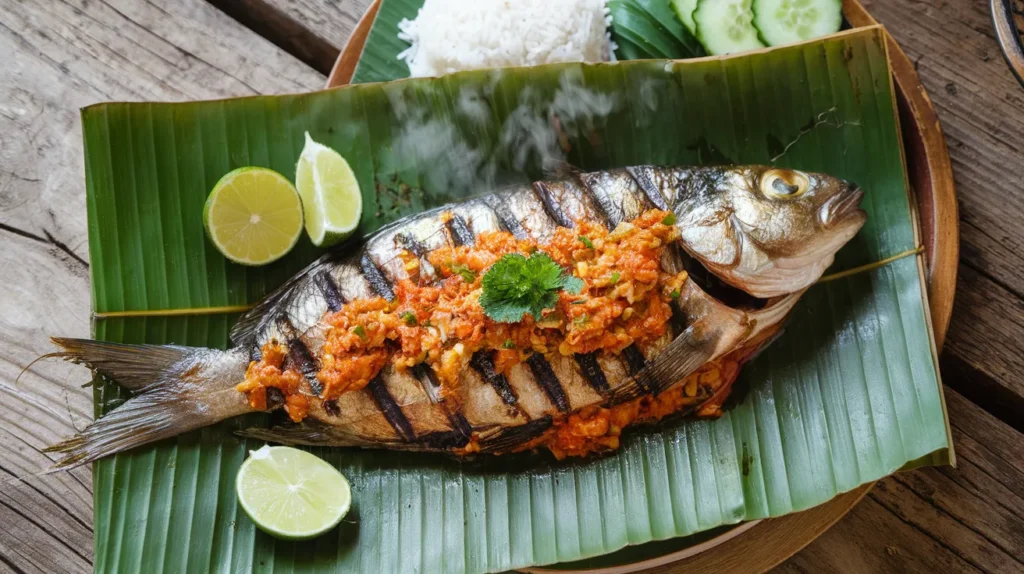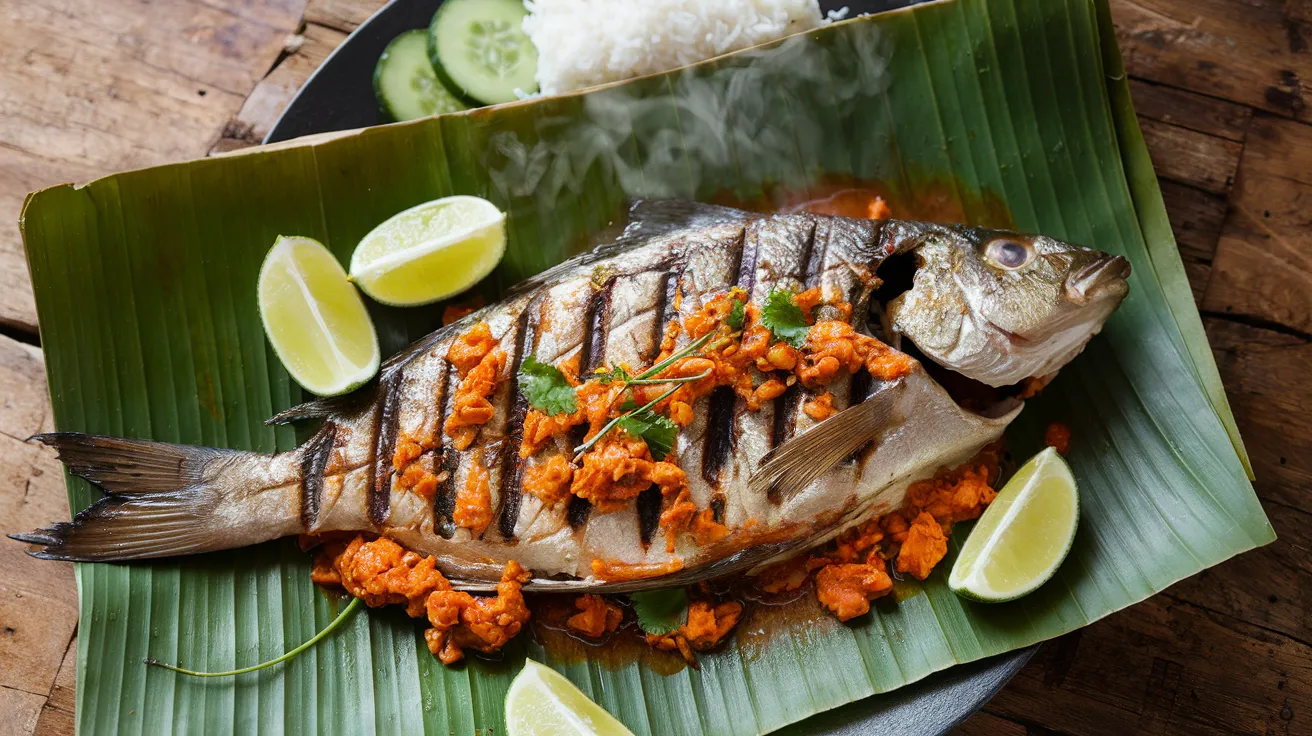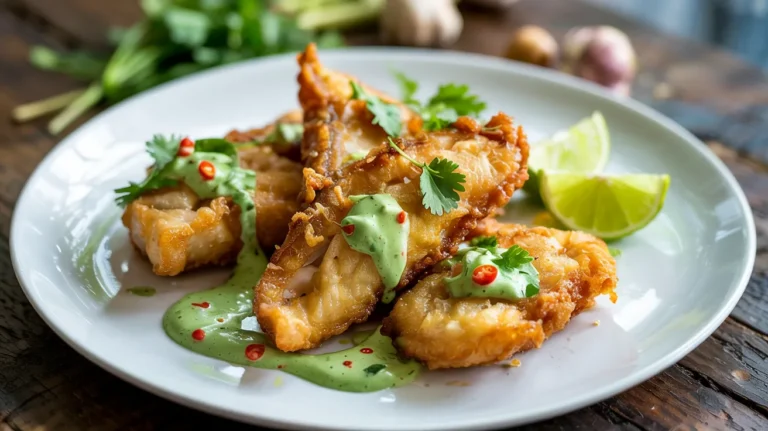Prep Time: 30 minutes | Cook Time: 15 minutes | Total Time: 45 minutes | Servings: 4 persons
Key Takeaways
- Authentic Ikan Bakar Malaysian Grilled Fish with spicy sambal sauce
- Perfect weekend grilling option ready in under an hour
- Customize heat level while maintaining traditional flavors
- Works with multiple fish varieties (sea bass, snapper, tilapia)
The Magic of Ikan Bakar Malaysian Grilled Fish
Craving bold flavors but stuck in a boring fish routine?
Ikan Bakar Malaysian Grilled Fish delivers that perfect combo of charred edges and aromatic spices that’ll make your taste buds dance. This recipe takes the intimidation out of exotic cooking and breaks it down into simple steps anyone can follow.
The secret lies in the sambal sauce—a flavor bomb that transforms ordinary fish into something extraordinary. With just 45 minutes of your time, you’ll create a meal that looks and tastes like it came straight from a Malaysian night market. Once you master this technique, you might also enjoy trying my Fish Cakes from Leftovers as another creative way to enjoy seafood at home.
Nutrition Comparison (Per Serving)
| Nutrient | Amount | % Daily Value |
|---|---|---|
| Calories | 310 kcal | 15% |
| Protein | 28g | 56% |
| Fat | 18g | 23% |
| Carbohydrates | 9g | 3% |
| Fiber | 2g | 7% |
| Sodium | 420mg | 18% |
What You’ll Need for Ikan Bakar Malaysian Grilled Fish
Ingredients List
| Ingredient | Quantity | Notes |
|---|---|---|
| For the Fish: | ||
| Whole fish (sea bass, red snapper, or tilapia) | 2 medium (about 1.5 lbs each) | Cleaned, scaled, and scored |
| Lime | 2 | 1 sliced for garnish, 1 for juice |
| Salt | 1 tsp | |
| Banana leaves (optional) | 4 large pieces | For wrapping/serving |
| For the Sambal Paste: | ||
| Shallots | 6 medium | Roughly chopped |
| Garlic | 4 cloves | Peeled |
| Fresh red chilies | 6-8 | Stems removed, adjust for heat preference |
| Lemongrass | 2 stalks | White parts only, sliced |
| Ginger | 2-inch piece | Peeled and sliced |
| Turmeric | 1-inch piece fresh or 1 tsp powder | Peeled if using fresh |
| Tamarind paste | 2 tbsp | |
| Brown sugar | 1 tbsp | |
| Vegetable oil | 3 tbsp | |
| Salt | 1 tsp |
Kitchen Tools
| Tool | Purpose |
|---|---|
| Food processor or mortar and pestle | For making sambal paste |
| Grill or grill pan | For cooking fish |
| Sharp knife | For scoring fish |
| Cutting board | For preparing ingredients |
| Mixing bowl | For marinating |
| Small bowl | For lime juice |
| Measuring spoons | For precise measurements |
| Basting brush | For applying sambal |
| Tongs | For flipping fish |
| Aluminum foil | If not using banana leaves |
| Kitchen timer | To track cooking times |
| Instant-read thermometer | To check fish doneness |
Substitutions (If Needed)
- Fish options: Any firm white fish works well
- Banana leaves: Aluminum foil makes a good alternative
- Fresh turmeric: Ground turmeric (1 tsp) works in a pinch
- Tamarind paste: 1 tbsp lime juice + 1 tsp brown sugar
- Fresh chilies: 2-3 tbsp chili paste or sambal oelek
Step-by-Step Instructions for Ikan Bakar Malaysian Grilled Fish
Preparation Phase (30 minutes)
1. Prepare Your Workspace (5 minutes)
- Gather all ingredients and place them on your counter.
- Check that you have everything listed in the ingredients section.
- Measure out all spices and aromatics before starting.
- Set up your cutting board and knife.
- Place a damp paper towel or kitchen towel under your cutting board to prevent slipping.
- Have a trash bowl nearby for scraps.
2. Prepare the Fish (10 minutes)
- Check that your fish is properly cleaned.
- If you purchased whole fish, ensure scales are removed.
- Check that the gills and internal organs have been removed.
- Rinse the fish under cold water and pat completely dry with paper towels.
- Score the fish on both sides.
- Place the fish on your cutting board.
- Using a sharp knife, make 3-4 diagonal cuts on each side of the fish.
- Each cut should be about ½-inch deep and spaced 1 inch apart.
- These cuts help the fish cook evenly and allow the marinade to penetrate.
- Season the fish.
- Cut one lime in half and squeeze the juice into a small bowl.
- Sprinkle ½ teaspoon salt inside the cavity of each fish.
- Sprinkle the remaining salt evenly over both sides of the fish.
- Drizzle the lime juice over both sides and inside the cavity.
- Use your hands to gently rub the salt and lime juice all over the fish.
- Let the fish rest for 10 minutes while you prepare the sambal paste.
3. Make the Sambal Paste for Ikan Bakar (15 minutes)
- Prepare the aromatics.
- Peel the shallots and garlic cloves.
- Cut the shallots into quarters.
- Remove stems from chilies. For less heat, remove the seeds as well.
- Peel the ginger and turmeric (if using fresh) and slice into thin pieces.
- Remove the tough outer layers of lemongrass and cut just the bottom 4 inches into thin slices.
- Blend the paste.
- If using a food processor:
- Add shallots, garlic, chilies, lemongrass, ginger, and turmeric to the food processor bowl.
- Pulse 8-10 times until ingredients are finely chopped but not completely smooth.
- Scrape down the sides of the bowl as needed.
- If using mortar and pestle:
- Start with the hardest ingredients (lemongrass, ginger, turmeric).
- Pound until broken down, then add garlic, chilies, and finally shallots.
- Continue pounding until you achieve a coarse paste.
- If using a food processor:
- Cook the sambal paste.
- Place a small pan over medium heat.
- Add 2 tablespoons of vegetable oil.
- When the oil is hot (it will shimmer slightly), add the blended paste.
- CAUTION: The paste may splatter, so stand back and be careful.
- Reduce heat to medium-low.
- Cook for 8-10 minutes, stirring frequently with a wooden spoon to prevent burning.
- The paste will gradually darken and become more fragrant.
- If it starts to stick, add 1-2 tablespoons of water.
- Finish the sambal.
- Add tamarind paste, brown sugar, and salt to the pan.
- Stir well to combine all ingredients.
- Cook for another 2-3 minutes until the mixture darkens slightly and becomes thick.
- You’ll know it’s ready when the oil starts to separate from the paste.
- Remove from heat and let cool for 5 minutes.
4. Prepare the Banana Leaves (If Using) (5 minutes)
- Clean the banana leaves.
- Rinse leaves under warm water to remove any dirt.
- Pat dry with paper towels.
- Make the leaves pliable.
- Hold a leaf with tongs.
- Pass quickly over an open flame (gas stove) or hot electric burner for about 5 seconds per side.
- The leaf will become shiny and flexible.
- Repeat with all leaves.
- Cut into pieces large enough to wrap around your fish.
Cooking Phase for Ikan Bakar Malaysian Grilled Fish (15 minutes)
5. Preheat Your Grill (5 minutes)
- Prepare your grill.
- For a gas grill: Turn on to medium-high heat (about 375-400°F).
- For a charcoal grill: Light charcoal and let burn until coals are covered with gray ash.
- For a grill pan: Heat over medium-high heat for 5 minutes.
- Clean and oil the grates.
- Use a grill brush to remove any debris from previous cooking.
- Fold a paper towel into a small square.
- Dip in vegetable oil.
- Using tongs, rub the oiled paper towel over the grates 3-4 times.
- This crucial step prevents the fish from sticking.
6. Apply the Sambal (5 minutes)
- Coat the fish with sambal paste.
- Using a basting brush, generously coat both sides of fish with sambal paste.
- Make sure to get the paste into the score marks.
- Don’t forget to brush some inside the cavity as well.
- Set aside about ¼ of the sambal for basting during cooking.
7. Grill the Fish (15 minutes)
- Place the fish on the grill.
- If using banana leaves: Place fish on banana leaf, then place the leaf on the grill.
- If not using leaves: Place fish directly on the well-oiled grates.
- Close the grill lid if using a covered grill.
- Cook the first side.
- Let the fish cook undisturbed for 5-6 minutes.
- You’ll know it’s ready to flip when it releases easily from the grates.
- If it sticks, give it another minute before trying again.
- Flip the fish carefully.
- Use two spatulas—one under the head and one under the tail.
- Gently lift and flip in one smooth motion.
- If using banana leaves, flip the entire leaf.
- Cook the second side.
- Baste the top side with more sambal paste.
- Cook for another 5-6 minutes.
- The fish is done when the flesh is opaque and flakes easily when tested with a fork.
- For absolute certainty, use an instant-read thermometer—the internal temperature should reach 145°F at the thickest part.
- Final check for doneness.
- Insert the tip of a knife into the thickest part of the fish.
- If it goes through easily and the flesh is opaque, the fish is done.
- If using a thermometer, insert it into the thickest part of the fish (usually behind the head).
8. Serve the Ikan Bakar Malaysian Grilled Fish (5 minutes)
- Transfer to serving platter.
- Carefully remove the fish from the grill using two spatulas.
- If you used banana leaves, you can serve the fish on them for presentation.
- If not, transfer to a serving platter.
- Final touches.
- Brush with remaining sambal for extra flavor.
- Cut the second lime into wedges.
- Arrange lime wedges around the fish.
- Serve immediately while hot.

Troubleshooting Tips for Ikan Bakar
| Problem | Solution |
|---|---|
| Fish sticking to grill | Make sure grates are very well oiled; consider using a fish basket |
| Sambal burning | Reduce heat and move fish to cooler part of grill |
| Fish falling apart | Don’t flip too early; use two spatulas for support |
| Undercooked fish | Add 2-3 minutes per side; check that thickest part reaches 145°F |
| Too spicy | Serve with coconut rice and cucumber to balance heat |
| Skin tearing | Make sure fish is completely dry before grilling |
| Flare-ups on grill | Keep a spray bottle of water nearby to tame flames |
| Fish cooking unevenly | Make sure fish is at room temperature before grilling |
Variations & Substitutions
Different Fish Options for Ikan Bakar
- Sea bass: Traditional choice with delicate flavor
- Red snapper: Slightly sweet with firm texture
- Tilapia: Budget-friendly option
- Mackerel: Stronger flavor that stands up well to spices
- Trout: Works well but cook for less time due to thinner flesh
Dietary Modifications
- Gluten-free: This recipe is naturally gluten-free
- Lower carb: Reduce or omit brown sugar in sambal
- Less spicy: Remove seeds from chilies or reduce quantity
- Dairy-free: Already dairy-free as written
If you’re looking for a fusion approach to fish recipes, you might also enjoy my Indian Fish Pie Recipe which combines similar aromatic spices in a completely different presentation.
Storage & Reheating
- Refrigeration:
- Store leftover fish in airtight container for up to 2 days
- Store leftover sambal separately for up to 1 week
- Freezing:
- Not recommended for the cooked fish as texture will suffer
- Uncooked sambal paste can be frozen in ice cube trays for up to 3 months
- Reheating:
- Oven method (best): Wrap in foil and heat at 275°F for 10-15 minutes
- Stovetop method: Place in covered skillet with 2 tablespoons water on low heat for 5 minutes
- Avoid microwave as fish will become rubbery
Safety Notes & Tips for Ikan Bakar Malaysian Grilled Fish
- Fish safety: Always cook fish to internal temperature of 145°F
- Handling chilies: Wear gloves when handling hot peppers; avoid touching eyes
- Banana leaves: Be careful when passing over flame to avoid burns
- Food processor safety: Ensure lid is secure before processing sambal ingredients
- Grill safety: Never leave a hot grill unattended
- Raw fish handling: Wash hands thoroughly after handling raw fish
Pro Tips for Success
- Room temperature fish cooks more evenly than cold fish; let sit out for 15 minutes before grilling
- Scoring the fish helps it cook evenly and absorbs more flavor
- Don’t rush the sambal cooking — those 10 minutes develop deep flavor
- Rest the fish for 5 minutes after grilling for juicier results
- Serve with coconut rice and cucumber salad for a complete meal
- Make extra sambal and store in refrigerator for up to a week for other dishes
- Pat fish very dry before seasoning to ensure crispy skin
- If cooking for kids, reduce the chili amount by half for a milder version




